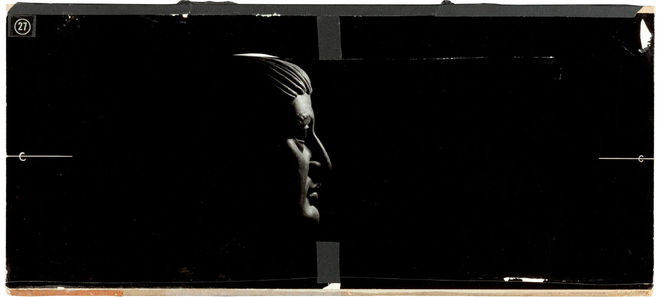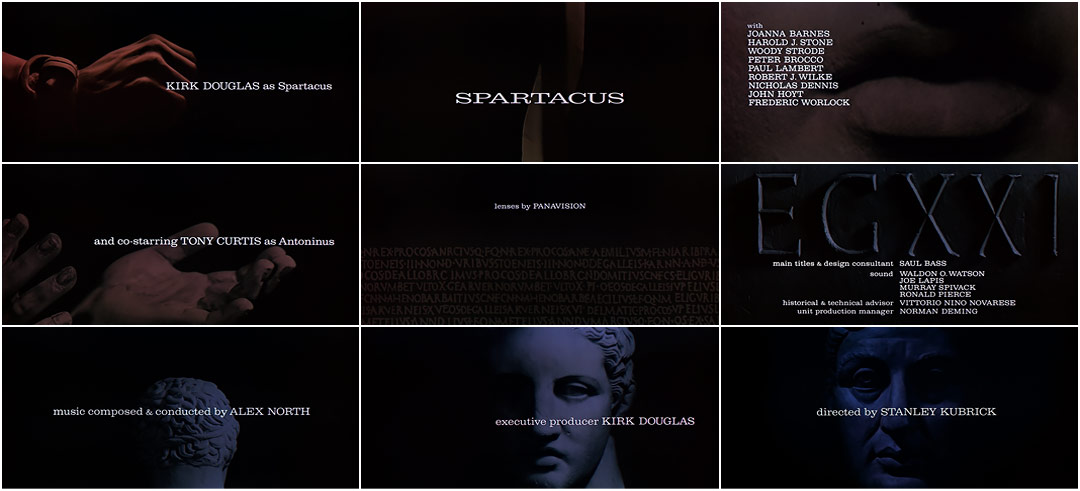Author Pat Kirkham discusses the opening titles for Spartacus, designed by Saul and Elaine Bass, from her authoritative book Saul Bass: A Life in Film and Design.
The story of a gladiator who leads a slave revolt against the might of the Roman Empire, Spartacus was a high-profile project for Kirk Douglas, who both produced and starred in the movie. A long standing admirer of Saul's work, Douglas hired him not only to create the title sequence and advertising campaign, but also as a visual consultant. His responsibilities included the design and storyboarding of the battle sequences, conceptualizing and designing the gladiatorial school and scouting the Nubian mine locations.
Saul and Elaine (this was the first sequence on which Elaine was a full collaborator) wanted the titles to establish the powerful presence of the Roman Empire.
Saul explained:
"What we were going for in the Spartacus titles was the multiple layers of elegant and disdainful faces, which express the duality of Roman rule — the oppressiveness and brutality, as well as the sophistication that made possible so many contributions to Western civilization. It seems very rich to see the growth of those profiles forming a full face, and full faces dissolving into profiles before the final face starts to crack apart and the camera zooms into the empty eye, signaling that all is not well."
The concept was relatively simple, but the precise effects they wanted proved difficult to achieve, especially because there were no zoom lenses available for the wide-screen Super Technirama 70 process in which the film was shot.
Saul recalled:
"We solved the problem by buying a few plaster heads, for thirty dollars a head, at a place across the street from the old Goldwyn studios that made plaster casts. At that price it didn't matter if we broke more than we used, and it saved renting an expensive studio and creating expensive special effects. We put the camera on a track and shot every frame as we made a series of tiny incremental move-ins. At each stop, Elaine would start and extend cracks in the head, getting nearer and nearer, until it was riddled with cracks and ready to fall apart. So far, so good ...
But how to have the head crack open and retain the mood of slow decay? We had to think of a way of it coming apart slowly. We wracked our brains and Elaine came up with a great idea. She recalled the Japanese bunraku theater where puppeteers dressed in black manipulate the puppets. Well, Elaine put on a pair of black gloves and draped herself in black cloth. She was on-camera while it was rolling and slowly pulled chunks out of the statue, just taking them away slowly until it fell apart."
Pat Kirkham is Professor in the History of Design, Decorative Arts and Culture at the Bard Graduate Center for Studies in the Decorative Arts, Design & Culture, New York. She has written and edited a number of books, including Charles and Ray Eames (1998) and Women Designers in the USA 1900–2000 (2001).
©2011 Laurence King Publishing Ltd. Used with permission.

SUPPLEMENTARY: Original Spartacus title sequence boards complete with shooting directions. Certain boards were flipped and reused throughout the sequence.
Title Designer and Design Consultant: Saul Bass
Main Titles – Director and Producer: Elaine Bass
Discover more Saul Bass

SAUL BASS: A LIFE IN FILM AND DESIGN
By Jennifer Bass and Pat Kirkham










